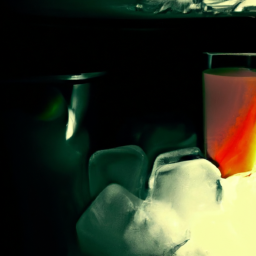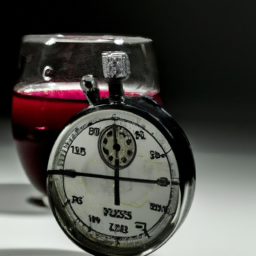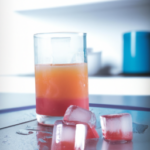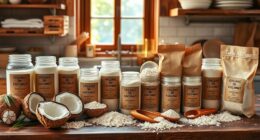I am passionate about making my own popsicles and smoothies, and I have often wondered how long it takes for juice to freeze. The freezing time can vary depending on factors such as the type of juice, the temperature of the freezer, and the type of container used for freezing.
Understanding the science behind freezing juice can help us make better decisions when it comes to preparing frozen treats. Juice is mainly composed of water, which freezes at 32°F (0°C). However, juice also contains sugars and acids, which can lower the freezing point of water. For example, the freezing point of orange juice is around 27°F (-3°C) due to its high sugar content.
Additionally, the size and shape of the container used for freezing can affect the time it takes for the juice to freeze. A shallow container will freeze faster than a deep one, as more surface area is exposed to the cold air.
Key Takeaways
- The time it takes for juice to freeze depends on several factors, including the type of juice, temperature of the freezer, container size and type, sugar content, and consistency of the juice.
- Freezing juice can result in ice crystal formation, texture and taste changes, and loss of flavor and nutrients.
- To freeze juice, it is recommended to use shallow containers, leave space for expansion, and use plastic or glass containers with airtight lids. Juice can be stored frozen for up to 8-12 months.
- When making popsicles, it is recommended to use shorter freezing times, add sweeteners and flavorings to enhance taste, and use molds with smaller cavities for faster freezing. Properly store popsicles in airtight containers and allow them to thaw before blending for smoothies.
The Science Behind Freezing Juice
Did you know that the science behind freezing juice involves the formation of ice crystals and the disruption of its molecular structure, ultimately affecting its texture and taste?
When juice is placed in a freezer, the temperature drops below its freezing point, causing the water molecules to slow down and come closer together. As the juice freezes, ice crystals begin to form, and these crystals grow larger as more water molecules join in.
Ice crystal formation is affected by the presence of nucleation sites in the juice. These sites are often found in impurities, such as dirt or bacteria, that act as a catalyst for ice crystal formation. The type of sugar in the juice can also affect the freezing process. Fructose, for example, doesn’t freeze as easily as glucose, which can lead to a softer texture in frozen juice.
Understanding these factors is crucial in determining the freezing time of juice.
Factors Affecting Freezing Time
When it comes to freezing juice, time is a slippery slope that can be influenced by a multitude of factors. Here are some factors that can affect the freezing time and texture of your juice:
-
Sugar content: Juices with a high sugar content freeze faster than those with lower sugar content. This is because sugar lowers the freezing point of liquids.
-
Type of juice: Different types of juice have different freezing times. For example, citrus juices freeze faster than apple juice.
-
Container size: The size of the container in which the juice is frozen can also affect the freezing time. Smaller containers freeze faster than larger ones.
-
Temperature of freezer: The temperature of your freezer is also a factor. The colder your freezer, the faster your juice will freeze.
All these factors can affect the texture of your frozen juice. If the juice is frozen too fast, it may form ice crystals, which can affect the texture and taste of the juice. On the other hand, if the juice is frozen too slowly, it may lose its flavor and nutrients.
Understanding these factors can help you freeze your juice properly and achieve the desired texture.
Now that we know the factors that affect freezing time and texture, let’s move on to general guidelines for freezing juice.
General Guidelines for Freezing Juice
Ready to freeze your juice? Here are some general guidelines to ensure your frozen juice maintains its flavor and texture.
First, it’s important to consider the consistency of your juice. If the juice is already quite thick, it may freeze faster than a thinner juice. Adding sugar or other sweeteners to the juice can also affect its freezing time. Generally, the freezing time for juice can range from 2-24 hours, depending on these factors.
Another important consideration is the container in which you freeze the juice. Plastic or glass containers with airtight lids are ideal, as they prevent freezer burn and maintain the quality of the juice. It’s also important to leave some space at the top of the container for the juice to expand as it freezes.
Once the juice is frozen, it can be stored for up to 8-12 months in the freezer.
When it comes to making popsicles, freezing juice for a shorter amount of time is generally recommended. This allows the juice to remain slightly slushy, making it easier to insert the popsicle sticks.
With these guidelines in mind, you can enjoy delicious, homemade frozen juice treats all year round.
Freezing Juice for Popsicles
When it comes to freezing juice for popsicles, there are a few key points to keep in mind. First, you may want to consider adding sweeteners or flavorings to enhance the taste.
Second, using popsicle molds can make the process much easier and more efficient.
Finally, removing the popsicles from the molds can be a bit tricky, but there are techniques that can make it simpler.
Make sure to double check your freezer settings and enjoy your homemade popsicles!
Adding Sweeteners and Flavorings
To enhance the taste, you can add sweeteners and flavorings to the juice before freezing it. Adding natural sweeteners like honey, agave, or maple syrup can give your popsicles a healthier touch while still providing the sweetness you crave. Avoiding artificial flavors is also recommended as they can add unnecessary chemicals to your popsicles. Instead, consider using fresh fruits or extracts like vanilla or almond to add flavor to your juice.
In addition to sweeteners and flavorings, you can also experiment with adding other ingredients to your juice before freezing it. For example, adding chunks of fresh fruit can add texture and flavor to your popsicles. Using coconut water instead of regular water can add a tropical twist. Adding herbs like mint or basil can give your popsicles a refreshing taste.
By incorporating these ingredients, you can create unique and delicious popsicles that are tailored to your taste preferences. Next, we’ll move on to the process of using popsicle molds.
Using Popsicle Molds
Now that you’ve added your desired sweeteners and flavorings, it’s time to get creative with your popsicle molds. There are a variety of alternative molds available in the market, ranging from silicone to stainless steel. However, it is important to keep in mind that the type of mold used can impact the freeze time and texture of the final product.
To ensure optimal freezing time, it is recommended to use molds with smaller cavities. This allows for faster and more evenly distributed freezing. Additionally, juicing techniques can also affect the freeze time. Using a juicer that produces pulp-free juice can result in a smoother texture and quicker freeze time. Ultimately, experimenting with different molds and juicing techniques can lead to a unique and delicious frozen treat.
As you wait for your popsicles to freeze, it’s important to keep in mind the next step: removing them from the molds.
Removing Popsicles from Molds
As the frozen popsicles eagerly wait to be freed from their molds, gently twist and pull on the stick to release them. But sometimes, even with the best molds, the popsicles can be stubborn and refuse to come out. Here are some tips for unmolding popsicles:
- Run the mold under warm water for a few seconds. This will help loosen the popsicle from the mold.
- Use a butter knife to gently run along the edges of the mold. This will help release any stubborn parts of the popsicle that are still stuck.
- Don’t force it. If the popsicle still won’t come out, let it sit at room temperature for a few minutes before trying again.
Preventing freezer burn on popsicles is also important. This can happen when the popsicles are not properly sealed or stored in the freezer. To prevent freezer burn:
- Use an airtight container to store the popsicles in the freezer.
- Make sure the popsicles are completely frozen before storing them.
- Avoid putting warm or hot popsicles in the freezer, as this can cause condensation to form and lead to freezer burn.
Now that we’ve covered tips for unmolding popsicles and preventing freezer burn, let’s move on to freezing juice for smoothies.
Freezing Juice for Smoothies
When it comes to freezing juice for smoothies, there are a few key points to keep in mind.
First, it’s important to properly prepare your fruits and vegetables by washing and cutting them into smaller pieces.
Next, you’ll want to blend them with your chosen juice to create a smooth texture.
Finally, make sure to store your smoothie packs in the freezer in airtight containers, and allow them to thaw for a few minutes before blending to enjoy.
Preparing Fruit and Vegetables
To prepare your fruits and vegetables for freezing, simply wash them thoroughly and chop them into bite-sized pieces before placing them in an airtight container and into the freezer.
It’s important to note that not all fruits and vegetables freeze well, and some may require additional preparation before freezing. For example, some fruits may need to be blanched before freezing to preserve their texture and flavor. Similarly, some vegetables may need to be steamed or roasted before freezing to prevent them from becoming mushy when thawed.
When it comes to juice preservation, juicing techniques can play a significant role in the freezing process. Freshly squeezed juice should be consumed immediately to ensure maximum nutritional benefits. However, if you wish to freeze your juice, it’s recommended to use a slow juicer or masticating juicer that produces less heat and oxidation, resulting in a longer shelf life.
Once frozen, the juice can be used for blending with other ingredients to make smoothies or consumed as a refreshing frozen treat.
Blending with Juice
You can easily mix in some of your frozen fruit or vegetable juice cubes with other ingredients to create a refreshing and nutritious beverage.
When blending with juice, it’s important to consider the juice’s consistency and flavor profile. For example, if you’re blending with a thicker juice like carrot or beet, it may be necessary to add some liquid like water or coconut water to achieve the desired texture. Similarly, if you’re blending with a sweeter juice like apple or grape, you may want to balance out the sweetness with some tart or bitter ingredients like lemon or kale.
Juice blending techniques can be a great way to incorporate more fruits and vegetables into your diet, and can also provide a plethora of health benefits. Drinking fresh, raw juice can help to boost your immune system, improve digestion, and provide your body with essential vitamins and nutrients.
When storing your blended juice, it’s important to keep in mind that the longer the juice sits, the more nutrients it loses. To prevent this, it’s best to store your juice in an airtight container in the refrigerator and consume it within 24 hours.
When thawing frozen juice cubes, it’s best to let them sit at room temperature for a few minutes before adding them to your blender, to ensure that they blend smoothly.
Storing and Thawing
Proper storage and thawing techniques are crucial for maintaining the maximum nutritional value of your blended juice and ensuring a smooth blending process. Here are some tips on how to store and thaw your juice properly:
-
Store your juice in airtight containers to prevent oxidation and spoilage. Glass jars with tight-fitting lids or BPA-free plastic containers work well.
-
Keep your juice refrigerated at a temperature between 32 and 41°F. This will slow down the growth of bacteria and help your juice keep its freshness for up to 72 hours.
-
When you’re ready to drink your juice, take it out of the refrigerator and let it sit at room temperature for about 15 minutes. This will help the juice to thaw and reach a more palatable temperature.
-
If you’re in a hurry, you can also thaw your juice in a bowl of warm water. Just be careful not to heat it up too much, or you’ll lose some of the nutritional value.
Now that you know the proper way to store and thaw your juice, you can enjoy it at its best.
In the next section, we’ll talk about how to freeze juice for cocktails.
Freezing Juice for Cocktails
When it comes to freezing juice for cocktails, there are a few key points to keep in mind. First, it’s important to choose the right juice for your recipe, whether it’s citrus for a margarita or cranberry for a holiday cocktail.
Second, when mixing with alcohol, it’s important to balance the flavors so that neither the juice nor the alcohol overwhelms the other.
Finally, consider serving suggestions such as garnishes or glassware to enhance the presentation of your cocktail.
Choosing the Right Juice
Hey there, if you’re looking to freeze some juice, make sure to choose one without any added sugar or preservatives to ensure a smooth and tasty frozen treat. When it comes to juice selection, it’s important to consider your flavor preferences. Some popular options for freezing include lemon, lime, grapefruit, orange, and cranberry juice. However, feel free to experiment with other juices to see what suits your taste buds best.
To help with your decision-making, here’s a table outlining the sugar content and freezing point of some common juices:
| Juice | Sugar Content (g per cup) | Freezing Point (°F) |
|---|---|---|
| Lemon | 1.6 | 28 |
| Lime | 2.4 | 28 |
| Grapefruit | 20.8 | 28 |
| Orange | 21.8 | 28 |
| Cranberry | 30.9 | 28 |
Now that you’ve chosen your juice and know its freezing point, you can start experimenting with different ways to mix it with alcohol.
Mixing with Alcohol
Now that we’ve discussed the importance of choosing the right juice for freezing, let’s talk about mixing it with alcohol. It’s important to keep in mind that the alcohol will lower the freezing point of the juice, so it may take longer for the mixture to freeze. Also, note that the more alcohol you add, the less solid the mixture will become.
Popular cocktail recipes that incorporate frozen juice include margaritas and daiquiris. For margaritas, simply blend frozen lime juice with tequila and triple sec. For daiquiris, blend frozen strawberry or mango juice with rum and lime juice. It’s important to adjust the alcohol content to your preference and take into account the freezing point of the alcohol used.
Moving on to serving suggestions, there are many creative ways to enjoy frozen juice and alcohol mixtures. From serving them in a hollowed-out fruit shell to adding fresh fruit garnishes, the possibilities are endless. Let’s dive into some fun and unique ways to present and enjoy these frozen cocktails.
Serving Suggestions
Get ready to impress your guests with these creative and visually stunning serving suggestions for your frozen juice and alcohol cocktails. Presentation ideas are just as important as the taste of the drink itself.
Here are three ideas to elevate your frozen cocktails to the next level:
-
Rim the glass with sugar or salt. This simple step adds a touch of elegance to any cocktail. Dip the rim of the glass into a shallow dish filled with sugar or salt, then twist the glass to coat the rim evenly.
-
Use edible flowers as a garnish. Not only do they add a pop of color to your cocktail, but they also provide a subtle floral flavor. Popular options include pansies, violets, and roses. Make sure to use only organic flowers that haven’t been treated with any chemicals.
-
Serve in unique glassware. Instead of using traditional glasses, try serving your cocktails in mason jars, copper mugs, or even hollowed-out fruit such as pineapples or watermelons. This unexpected twist will surely impress your guests and make for a memorable experience.
As you plan your cocktail party, you may be wondering how to speed up the freezing process. There are a few techniques to try that we’ll discuss in the next section.
Speeding Up the Freezing Process
To speed up the freezing process of juice, you can place it in the freezer for 30 minutes before transferring it to the fridge, which can reduce the freezing time by up to 50%.
Another method is quick freezing, which involves pouring the juice into a shallow container and placing it in the freezer. This allows for faster and more even freezing.
If you want to speed up the process even further, you can use the ice bath method. Simply fill a larger container with ice and place the juice container in the ice bath. This can help to lower the temperature of the juice more quickly and speed up the freezing process.
Another option for faster freezing is to use dry ice. This can be placed in a cooler or insulated container along with the juice, which will cause the temperature to drop rapidly and freeze the juice faster. However, it’s important to handle dry ice with care as it can be dangerous if not handled properly.
With these methods, you can reduce the time it takes for your juice to freeze and have a refreshing drink ready in no time.
Now, let’s take a look at ways to slow down the freezing process and ensure your juice is frozen perfectly.
Slowing Down the Freezing Process
If you want your frozen juice to have a smoother texture, you can slow down the freezing process by placing it in the back of your fridge where the temperature is colder. However, there are other ways to slow down the freezing process that can help you achieve a smoother texture. Here are some options you can consider:
-
Using insulating containers: Insulating containers, such as a thermos or a cooler, can help slow down the freezing process by keeping the temperature inside the container more consistent. This can help prevent the formation of ice crystals, which can cause the texture of your frozen juice to become grainy.
-
Using a colder freezer setting: If you have a freezer with adjustable temperature settings, you can lower the temperature to slow down the freezing process. However, it’s important to note that freezing food at too low a temperature can damage its quality and texture, so be sure to check the manufacturer’s recommendations for your freezer.
-
Pre-freezing containers: If you’re using individual containers to freeze your juice, you can pre-freeze them before adding the juice. This can help the juice freeze more slowly and prevent the formation of ice crystals.
-
Salt and ice baths: Another way to slow down the freezing process is to use a salt and ice bath. This involves placing your container of juice in a larger container filled with ice and salt. The salt lowers the temperature of the ice, which can help the juice freeze more slowly and evenly.
By using these techniques, you can achieve a smoother texture for your frozen juice. However, once your juice is frozen, you’ll need to know how to thaw it properly to maintain its quality.
Thawing Frozen Juice
When thawing frozen juice, it’s important to choose the right method to avoid temperature shock and preserve the quality of the juice.
I typically opt for a slow thaw in the refrigerator, which can take anywhere from a few hours to a day or more depending on the size of the container.
If you have leftover juice after thawing, it’s important to handle it properly to avoid contamination and consider ways to reuse it in recipes or drinks.
Choosing the Right Method
Picking the perfect freezing technique is key to getting your juice frozen in a jiffy. Alternative methods can be used to freeze juice quickly, such as using dry ice or liquid nitrogen. However, these methods require special equipment and should only be attempted by professionals.
For home use, the best way to freeze juice is to use a standard freezer. It’s important to choose the right freezing container for your juice, such as a plastic container or a freezer-safe glass jar. Make sure to leave some room at the top of the container to allow for expansion as the juice freezes.
Once your juice is in the container, place it in the freezer and wait for it to freeze completely. To avoid temperature shock when thawing frozen juice, it’s important to gradually raise the temperature. This can be done by placing the container in the refrigerator overnight or by running it under cool water.
By taking these precautions, you can enjoy your frozen juice without any loss of flavor or quality.
Avoiding Temperature Shock
To ensure the best taste and texture, it’s crucial to gradually thaw your frozen juice. When juice is frozen too quickly or thawed too rapidly, it can result in temperature shock, causing crystal formation within the juice. The best way to prevent this is to freeze your juice slowly and thaw it gradually in the refrigerator.
Another factor to consider when freezing juice is the choice of container. Glass and plastic containers are both suitable options, but it’s important to ensure that the container is freezer-safe and has enough space for expansion as the juice freezes. Choosing the right container can also help prevent temperature shock and crystal formation.
Transitioning into the subsequent section about reusing leftover juice, it’s important to note that properly thawing and storing your frozen juice can also make it easier to reuse in recipes or as a refreshing drink.
Reusing Leftover Juice
If you’ve got some extra juice on hand, there are plenty of ways to repurpose it into delicious and refreshing treats. Instead of throwing it out, consider using it to make popsicles, smoothies, or even as a marinade for your favorite meats. With a little creativity, you can reduce waste and turn your leftover juice into something new and exciting.
One fun way to use leftover juice is by making popsicles. Simply pour the juice into popsicle molds and freeze for a refreshing treat on a hot day. You can also mix different types of juice together to create unique flavor combinations.
Another option is to use the juice in a smoothie. Blend it with some frozen fruit, yogurt, and ice for a healthy and delicious drink.
Finally, try using the juice as a marinade for your meats. The acidity in the juice can help tenderize the meat and infuse it with flavor.
With these creative uses, you can reduce waste and enjoy your leftover juice in new and delicious ways.
There are many ways to repurpose leftover juice and reduce waste. The possibilities are endless. By getting creative and thinking outside the box, you can turn your extra juice into something new and exciting.
Summary of Tips and Tricks
When you’re in a rush and want your juice to freeze quickly, try using a shallow container instead of a deep one. This allows for more surface area and faster freezing time. Additionally, consider placing the container in the coldest part of your freezer, which is typically at the back. This will ensure that the juice freezes evenly and in the shortest amount of time possible.
Here are some more tips and tricks to ensure that your juice freezes properly and maintains its consistency:
- Avoid using glass containers, as they’re more likely to crack or break in the freezer.
- Make sure to leave some room at the top of the container for expansion as the juice freezes.
- Cover the container tightly with plastic wrap or an airtight lid to prevent freezer burn.
- If you want your juice to freeze faster, consider adding a little bit of sugar or alcohol to lower the freezing point. Just be careful not to add too much, as it may affect the flavor of the juice.
Frequently Asked Questions
What is the best type of juice to freeze for popsicles?
When choosing fruit for popsicles, consider the freezing process. High water content fruits will freeze better, such as watermelon or grapefruit. Avoid fruits with low water content, such as bananas or avocados, as they will result in a harder texture.
Can you freeze juice with added sugar or artificial sweeteners?
Yes, juice with added sugar or artificial sweeteners can be frozen. However, the freezing process may take longer due to the higher sugar content. Sugar substitutes may freeze faster, but may also affect the taste and texture of the juice.
How long can I keep frozen juice in the freezer before it goes bad?
After thorough research, I’ve found that frozen juice can last up to 8-12 months in the freezer, but it’s best to consume within 6 months for optimal taste. Freezing time varies by type of juice and can affect texture, but defrosting doesn’t impact taste.
Can I freeze freshly squeezed juice or does it need to be pasteurized first?
Freshly squeezed juice can be frozen without pasteurization. It’s best to freeze it immediately after juicing to maintain freshness. Freezing time varies but generally takes 2-4 hours. Shelf life in the freezer is 6-8 months.
Are there any specific containers or materials that are better for freezing juice?
When freezing juice, glass containers are better than plastic, as they prevent freezer burn. Choose a container with an airtight seal and leave space for expansion. Avoid diluting the juice with ice.
Conclusion
In conclusion, understanding the science behind freezing juice and the factors that affect its freezing time can help you achieve the desired texture and consistency when using it for popsicles or smoothies. Following general guidelines such as using freezer-safe containers and leaving room for expansion can also ensure successful freezing. However, if you want to speed up the process, using a colder freezer or pre-chilling the juice can help, while slowing down the process can be achieved by adding sugar or alcohol.
Lastly, proper thawing techniques can maintain the quality of the frozen juice. To sum up, freezing juice may seem like a simple task, but paying attention to the details can make a significant difference in the end result. By using the tips and tricks mentioned in this article, you can ensure that your frozen juice is of high quality and can be used in a variety of ways. So next time you’re freezing juice, remember to consider the science behind it and follow the guidelines to achieve the desired texture and consistency.
Ilana has been a vegan for over 10 years. She originally made the switch for health reasons, but soon found herself becoming more and more passionate about the ethical and environmental implications of a vegan lifestyle. Ilana is the author of The Graceful Kitchen, a blog all about veganism. She loves to cook up delicious and nutritious vegan meals, and share her recipes with others who are interested in leading a cruelty-free life. Ilana is also a strong advocate for using whole foods as the foundation of a healthy diet, and believes that going vegan is one of the best ways to achieve this.
















